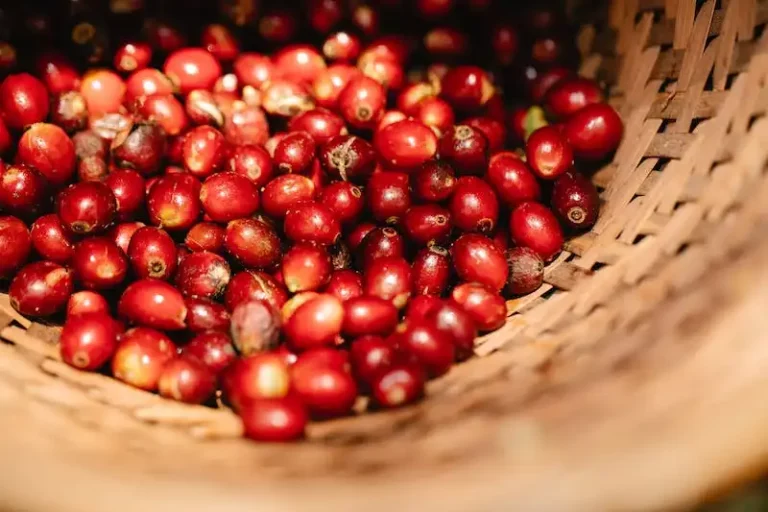What’s more idyllic than peering into a garden filled with plants and yellow flowers while holding a cup of coffee in the morning? Okay, maybe you prefer tea, but you get the picture!
Since plants that flower gorgeous yellows exude hope, positivity, and happiness, we thought it would be an excellent idea to run you through a few of them. Sowing these plants can add a splash of color to your home and garden, boost your mood, and transform your space, per Country Living. Some of these plants moonlight as medicinal herbs, too. They also promise to reduce anxiety, improve relaxation, prevent migraines, and ease nausea. But of course, be sure to speak to your healthcare provider before using them as a herb or dietary supplement.
If you are ready, we present 15 plants with yellow flowers for your flower garden, their botanical names, and everything you may need to get started with sowing.
1. Billy Buttons
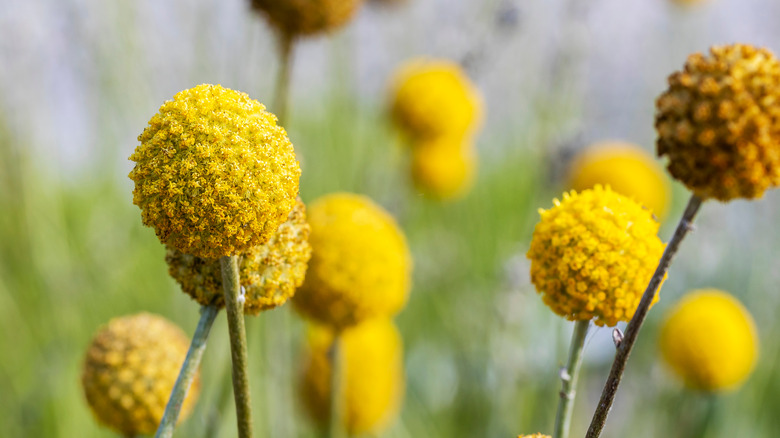
Billy Buttons (Craspedia globosa) are gorgeous perennial plants native to Australia and New Zealand. They resemble golden golf balls, consisting of narrow, wooly, flowering leaves perched on long, stout stems. Billy Buttons are easy to grow from seed, as long as they receive a minimum of six hours of direct sunlight, per Gardener Know How. After the seeds germinate, make sure to transplant them to a sunny or slightly shady area. Since these plants grow best in swampy areas, we recommend sowing them in loamy, clay loam, or sandy loam soils.
Bloom Season: spring, summer
USDA Growing Zone: 8 to 11
Growing Conditions: full sun or partial shade
Soil Type: moist, well-draining soil
Size: 24 to 30 inches tall, 12 to 24 inches wide
2. Dahlia yellow star
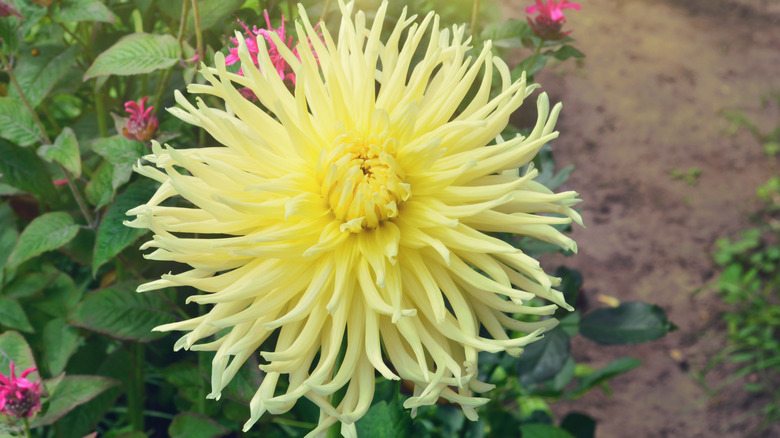
Dahlia yellow star (Cactus dahlias) is one of the few plants with yellow flowers native to Mexico and Central America. They bear rich, yellow flowers that pale slightly toward their elongated petals. Dahlia yellow stars are famed for their spectacular petals consisting of spiky, double blooms. As long as you plant them in sunny areas, provide consistent moisture, and protect them from strong winds, you should see them bloom well into fall when most outdoor plants have passed their prime. To prolong the flowering season, Garden Tags suggests regular deadheading.
Bloom Season: summer, late fall
USDA Growing Zone: 8 to 11
Growing Conditions: full sun, consistent moisture
Soil Type: moist clay, loam, or sandy soil; well-draining
Size: 3 to 4 inches tall, 1 to 2 inches wide
3. Evening primrose
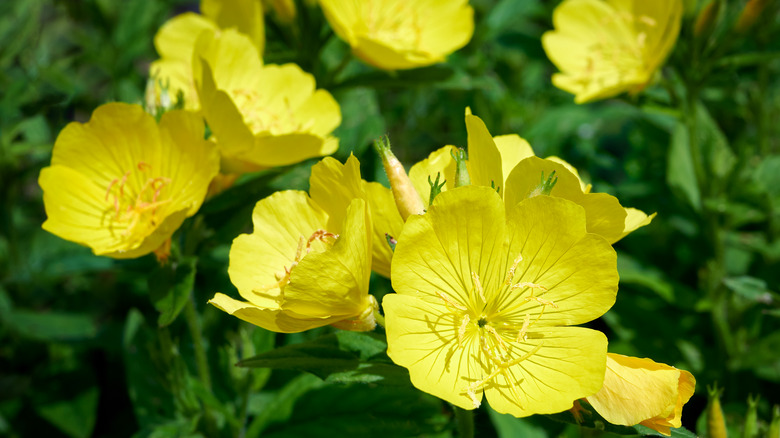
Alena Charykova/Shutterstock
Evening primrose (Oenothera biennis) attracts nighttime pollinators like moths since they are nocturnal, says the Lady Bird Johnson Wildflower Center. They show off their bloom at sunset and remain closed throughout the day. These flowers have a broad native range: North and South America, Europe, and some parts of Asia. Though evening primroses can be invasive if not properly cared for, they grow beautifully. If you can handle them, plant them in early spring or late fall. Please note that this plant can be toxic to cats and dogs when ingested.
Bloom Season: summer, early fall
USDA Growing Zone: 4 to 9
Growing Conditions: full sun and partial shade
Soil Type: moist, well-draining soil
Size: 3 to 5 feet tall, 2 to 3 feet wide
4. Impatiens
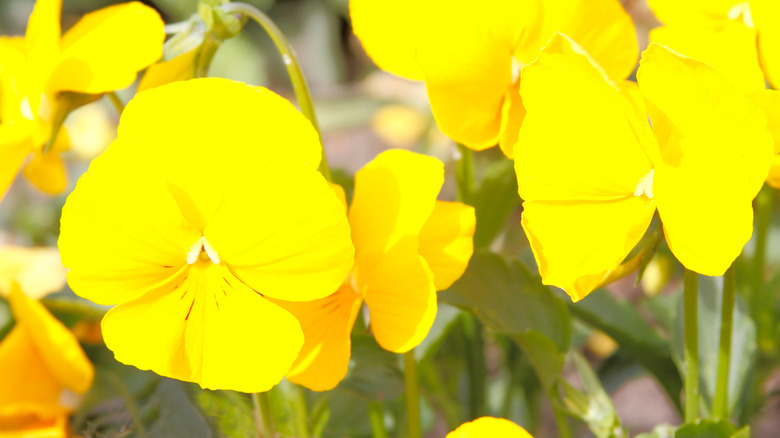
MikeBraune/iStock
If you are looking for plants with yellow flowers to upgrade your garden from dull to fierce, start with impatiens (Impatiens repens). It is a species of flowering plant in the family Balsaminaceae, native to Sri Lanka. Impatiens love moisture, are effortless to grow, and can thrive anywhere. Pro tip: plant them in dark, shady spots to cheer up your garden scene. As the University of Minnesota states, deer and rabbits love the succulent stems of impatiens, so be sure to treat your plants with a spray-on or repellent.
Bloom Season: spring through summer
USDA Growing Zone: 8 to 11
Growing Conditions: partial to deep shade
Soil Type: rich, well-drained soil
Size: 10 to 16 inches tall, 10 to 15 inches wide
5. Black-eyed Susan
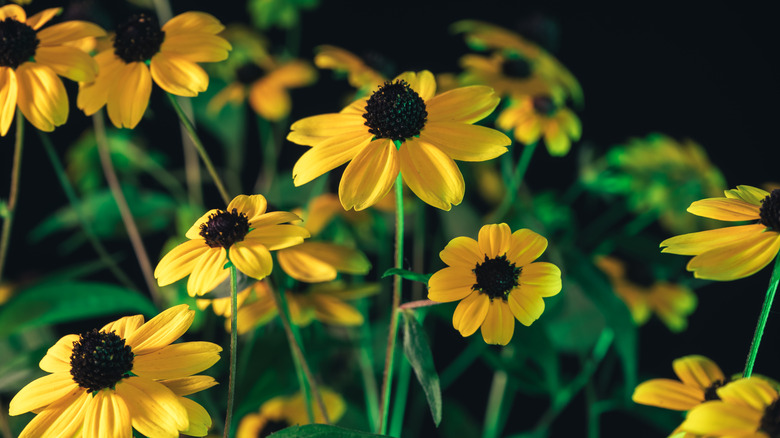
Bushko Oleksandr/Shutterstock
Black-eyed Susan (Rudbeckia hirta) is a North American plant that thrives in full sun and partial shade. American Meadows describes them as having sultry black eyes and bright petals that emanate pure joy. Black-eyed Susans are self-sowing and can be somewhat invasive, so we recommend spacing them 18 inches apart and dividing the clumps every four to five years to limit the spread. As low-maintenance wildflowers, they are best propagated through seed, division, and stem cuttings.
Bloom Season: summer, fall
USDA Growing Zone: 3 to 9
Growing Conditions: full sun to partial shade
Soil Type: various soil types
Size: 1 to 3 feet tall, 1/2 to 3 feet wide
6. Kalanchoe
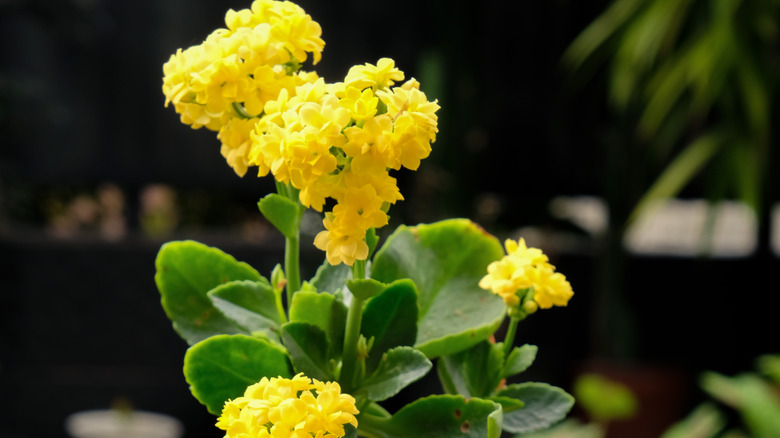
Sassi Photoworks/Shutterstock
We cannot discuss plants with yellow flowers without mentioning the Madagascar native, Kalanchoe (Kalanchoe blossfeldiana). According to Clemson University, this plant consists of small, clustered flowers perched atop dark green leaves, with as many as 26 petals per bloom. Kalanchoe is generally low-maintenance, requiring little water and lots of light. For best results, maintain a pH soil level of 5.0 and 7.0 and sit the plant close to a south-facing window in the winter, if indoors. East or west-facing windows with bright, indirect light will do in the summer.
Bloom Season: early spring to late winter
USDA Growing Zone: 10 to 12
Growing Conditions: little water, full sun to partial shade
Soil Type: well-aerated, well-draining potting soil mix
Size: 8 to 12 inches tall, 3 to 6 feet wide
7. Lollipop plant
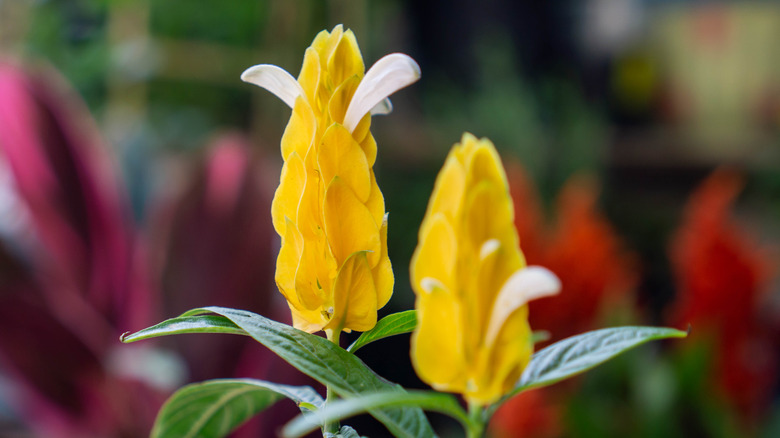
Rizky Sugianto/Shutterstock
Also known as the golden shrimp plant, the Lollipop plant (Pachystachys lutea) is a tropical, evergreen shrub native to Peru. It is soft-stemmed, producing small, white flowers from large, yellow, or golden cone-shaped bracts. The Lollipop plant best suites outdoors, but it thrives indoors, too, in bright spaces with indirect sunlight. House Plant Experts advise that you maintain a regular pruning schedule when growing them as houseplants. Consider dipping about 4 inches of stem in rooting hormone before planting in a well-draining potting soil mix.
Bloom Season: spring through fall
USDA Growing Zone: 9 to 11
Growing Conditions: indirect sunlight; water frequently in the summer, but not winter
Soil Type: well-draining potting soil mix
Size: 1 to 2 feet indoors, 4 feet outdoors; 2 to 3 feet wide
8. Orchids
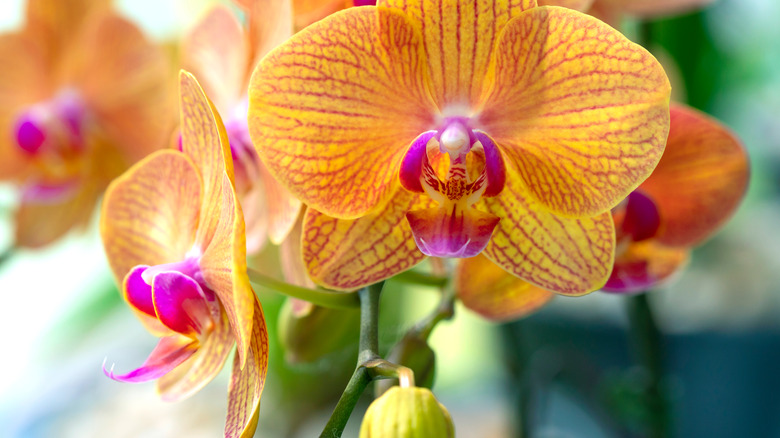
Jee1999/Shutterstock
Did you know there are about 28,000 species (via The Spruce) of orchids (Orchidaceae), making the second-largest group of flowering plants in the world? The orchid plant favors shallow planting, damp, well-draining soil, and humidity of about 50% to 70%. While it enjoys water, Gardening Know How recommends checking the moisture content of the soil before watering and only doing so if it is dry. They also ask that you keep insecticide soap handy since orchid plants are susceptible to pests and diseases. As one of the few long stalk houseplants with yellow flowers, orchids are experts at facelifting a room.
Bloom Season: fall, winter, or spring
USDA Growing Zone: 6 to 9
Growing Conditions: humidity, indirect light, ample watering
Soil Type: well-draining soil mix
Size: varies, depending on the species
9. Daffodils
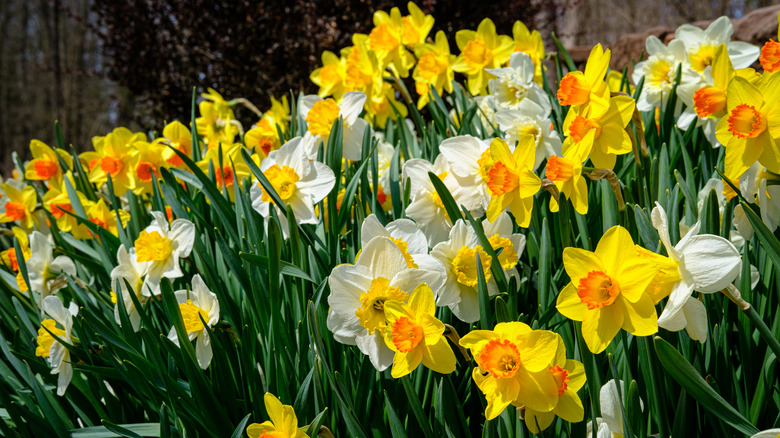
Bruce Peter/Shutterstock
How can we not discuss daffodils (Narcissus), one of the best things to come out of Northern Europe? With over 50 species, not counting hybrids, daffodils offer different colors, sizes, and unique characteristics. Our favorite, of course, is when it is in its classic trumpet shape, with six yellow petals and a long stem. Plant daffodils in the fall, two to four weeks before the ground hardens. Their spot should offer full sunlight and fertile, well-draining soil. The Old Farmer’s Almanac writes that though the variety of daffodil determines the soil type, most do well in neutral and acidic soils.
Bloom Season: spring
USDA Growing Zone: 3 to 8
Growing Conditions: full sun, at least six hours a day
Soil Type: rich, moist, well-draining
Size: varies, depends on the species.
10. Bromeliad
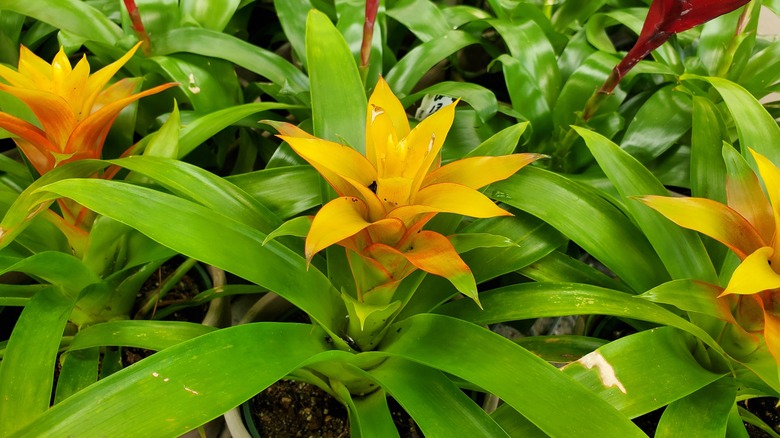
Poring Studio/Shutterstock
If you live in a humid climate, we have something for you. Bromeliad (Bromeliaceae genera) is a monocot flowering plant native to West Africa and the tropical Americas. These plants boom exceptionally well in moisture-holding, fast-draining potting soils. An ideal mix, according to The Spruce, is two-thirds peat-based soil and one-third sand. We must mention that bromeliads are slow-growing plants that bloom once in their lifetime. The good news, though, is that its flowers can last anywhere between three to six months.
Bloom Season: once, varies
USDA Growing Zone: 10 to 11
Growing Conditions: humidity; bright indirect sunlight or dappled shade
Soil Type: fast-draining potting soil
Size: 1 inch to 3 feet tall; an average of 3 feet wide
11. Hollyhock
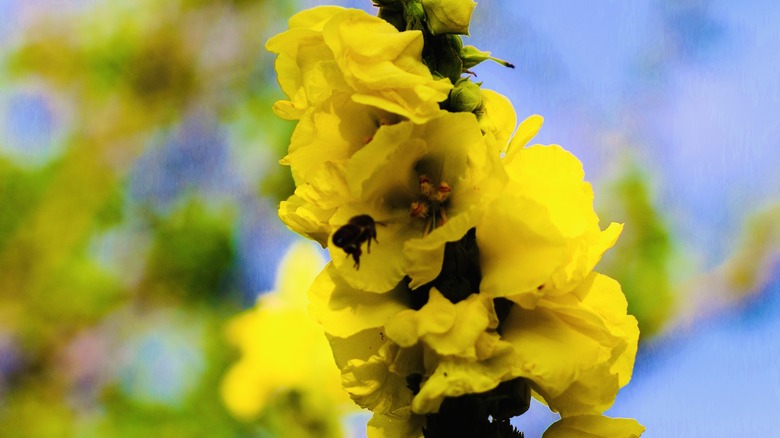
Beekeepx/Shutterstock
Most gardeners would agree: cottage-style homes and white picket fences seem incomplete without Hollyhocks (Alcea rosea). Hollyhocks are native to China and prefer rich, well-draining soil with full sun to partial shade. Due to their impressive heights and self-seeding capabilities, we recommend that you plant them in an area where they would not get in the way. According to North Carolina State University, Hollyhocks are susceptible to pests and diseases, so be sure to check your plants.
Bloom Season: summer
USDA Growing Zone: 3 to 8
Growing Conditions: full sun to partial shade
Soil Type: rich, moist, well-draining soil
Size: 6 to 8 feet tall, 1 to 2 feet wide
12. Goldenrod
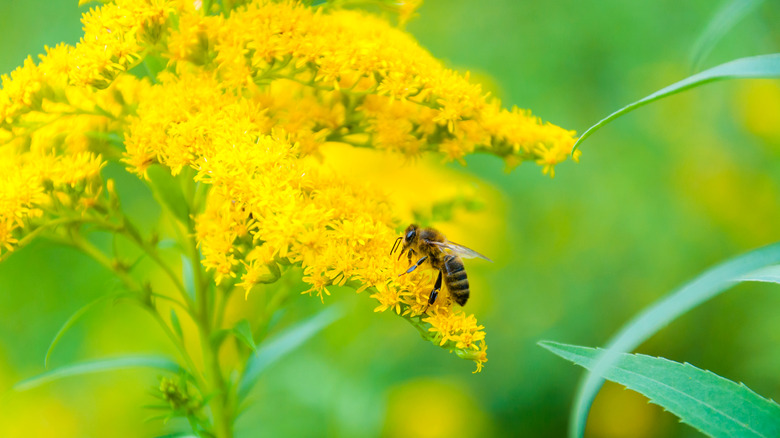
YKD/Shutterstock
Goldenrod (Solidago) is a perennial plant native to North America. It is a wildflower that can thrive wherever there is full sun and well-draining soil. Goldenrods tolerate drought well and require very little water, according to Piedmont Master Gardeners. Since they are plants with yellow flowers that produce nectar, it is advisable to plant them in your vegetable garden to draw bugs away from your produce. The plant is medicinal, too; per Healthline, it can help alleviate inflammation, stop muscle spasms, improve urinary health, and support the treatment of UTIs.
Bloom Season: late summer to fall
USDA Growing Zone: 3 to 9
Growing Conditions: full sun
Soil Type: not picky but must be well-draining
Size: 1 to 5 feet tall, 1 to 3 feet wide
13. Marigold
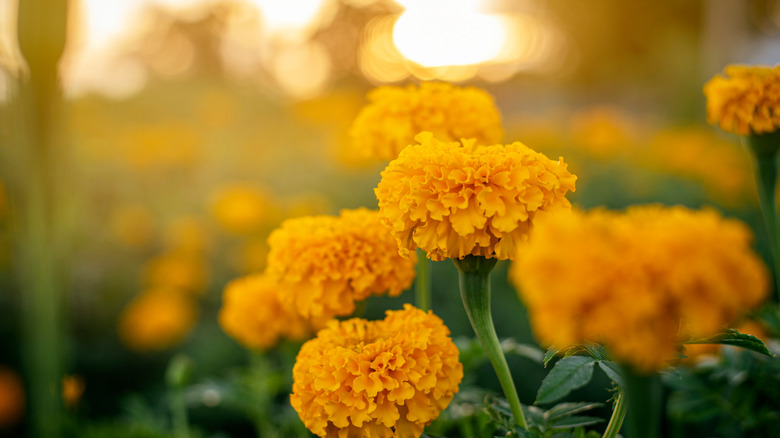
Yotwarit maliwong/Shutterstock
The name alone, marigold (Tagetes erecta), is utterly enchanting! Sowing this flower in your garden can be one of the most delightful ways to add warmth and beauty to your home. Garden Design classifies marigold as a fast-growing plant, as its seeds germinate quickly and bloom within eight weeks. Plant them in areas with full sun while protecting them from damaging winds and harsh rains. Pro tip: Water regularly in the dry season, but allow the soil to lose a little moisture between waterings when it is humid.
Bloom Season: late spring to fall
USDA Growing Zone: all zones
Growing Conditions: full sun; water at the base, not overhead
Soil Type: rich sandy or loam mixture, well-draining
Size: 6 to 12 inches tall and 6 to 9 inches wide
14. Large-flower tickseed
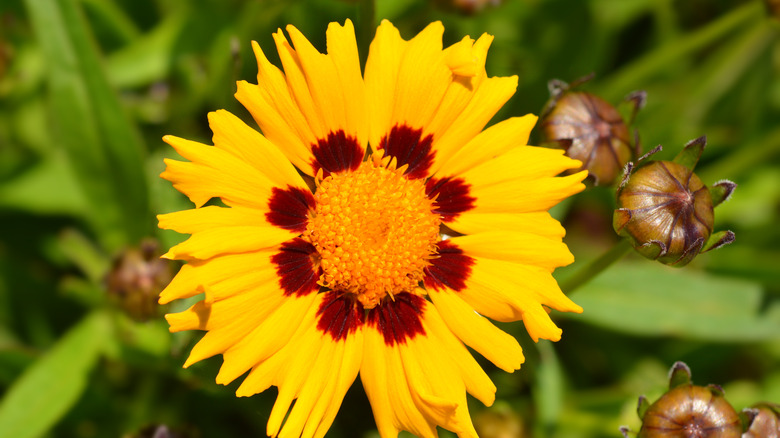
Nahhana/Shutterstock
One of the most beautiful plants with yellow flowers is the large-flower tickseed (Coreopsis grandiflora). It is North and Central American native, favoring sandy and rocky soils for its dry but well-draining properties. Large-flower tickseeds are drought-tolerant perennials that bloom well in full sun or partial shade. Since they reseed after being established, Gardeners World recommends spacing them 40 to 50 cm apart. We love the versatility of the various species — annual tickseeds do well in potting mediums, while taller species are excellent for borders. Though snails and slugs may attack the seedlings, large-flower tickseeds, in most cases, are resilient and low-effort.
Bloom Season: summer, fall
USDA Growing Zone: 2 to 11
Growing Conditions: full sun to light shade
Soil Type: sandy, rocky soil mix; well-draining
Size: varies by species
15. Daylily
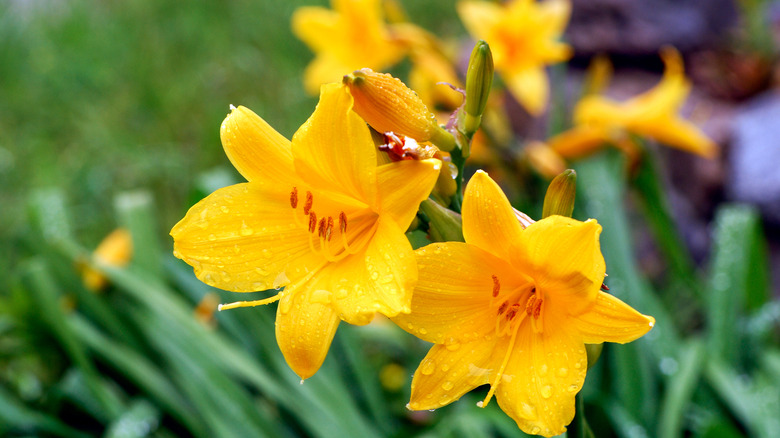
Oskars Kupics/Shutterstock
There are several species of daylilies (Hemerocallis lilioasphodelus), each as lovely as the other! The best time to plant these eastern Asian beauties is early spring or early fall. They take about a year to establish before spreading to form dense clumps. Daylilies are tough and can tolerate any soil quality as long as it is well-draining. Even though they are highly adaptable, they bloom best in slightly acidic soils and areas where they can receive at least six hours of sun. For best results, Garden Design recommends consistent watering, about an inch per day, and deadheading regularly.
Bloom Season: summer
USDA Growing Zone: 3 to 9
Growing Conditions: full sun, may tolerate light shade
Soil Type: all types, well-draining
Size: 1 to 3 feet tall, 1 to 3 feet wide


